News
Lanka’s rescue efforts attain Himalayan proportions in Nepal
When Major Dr. Cyril Kuruge was requested to take a relief Mission to Nepal on April 25, just hours after the devastating earthquake struck, he
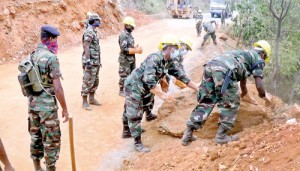
Lankan troops involved in operations in Nepal (above and right top)
agreed without hesitation. He was asked to get his teams organised and be on standby.
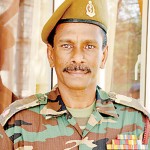
Major Dr. Cyril Kuruge
“I immediately prepared the drugs list and ordered them. I also got a team of nurses and medical assistants ready to leave immediately,” he said. A seasoned medical professional with experience in the war and working in Haiti, he knew exactly what medicines to take along.
While the teams were willing to go they faced practical problems. Their passports were at home, and they didn’t have sufficient uniforms to last them for a long stay.
“They immediately prepared new travel documents for us, borrowed uniforms from colleagues and by 11 am the following day (26) we were in Kathmandu,” Major Kuruge recalled.
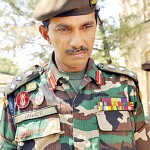
Brigadier Jagath Gunewardena
The first team comprised 48 members including Army engineers and four civilian doctors.
Dr. N.K. Warnakula was one of the four civilian doctors who volunteered to go to Nepal, who had earlier volunteered medical assistance to victims of the Philippines’ Typhoon in 2013. Hence, Dr Warnakula too knew what to expect.
“There was very little time for me to decide, I didn’t think of the risks. If you have good intentions, no harm will come to you,” says Dr. Warnakula.
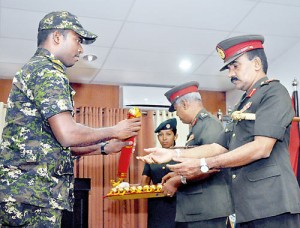
Felicitation ceremony: Surgeon Lt Dr Kosala Tennakoon (L), Dr. N.K. Warnakula (R) recive certificates of appreciation from the Army Commander
On arrival at the airport, the team was asked to wait for further instructions from the Nepalese government.
“It was around 1.30 pm, we were inside an iron shed in the airport, when we felt the first major aftershock of 6.4 magnitude. The Nepalese people ran out of their sheds like the one we were in. We followed them. We were concerned for our safety, but this was to be expected,” Dr Warnakula, a father of two, said, recalling his first encounter with earthquakes.
“I did not have time to arrange for insurance and there is no compensation scheme in the ministry either,” he said.
However, there was no time to worry about safety. By 3 p.m. they set off to Dolalghat, a remote hilly earthquake-affected area. “The Nepali Army Commander asked us if we could go to Dolalghat, a very rural and a difficult area to reach. We agreed and travelled there by road, along with a Nepalese Army officer who was also our interpreter,” Major Dr Deshan Dissanayake explained.
Within two hours of setting up camp casualties started pouring in, recalled Major Kuruge. Most days the doctor stationed at the camp treated over 100 patients, with some civilians acting as interpreters.
“Some civilians informed us that more villagers were trapped on hilltops and unable to come down for medical treatment,” said Dr Dahanayake.
On hearing this, the medical relief team decided to form smaller units and go to the patients instead. However, this was not an easy task. The injured were trapped on hilltops not accessible by vehicles.
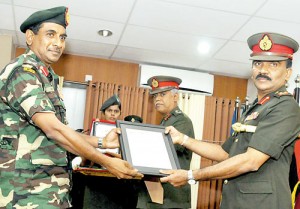
Maj. Gen. Maithri Dias (left) presents Army Commander with token of appreciation given by the Nepalese Govenment
Troops of the Engineering division were instrumental in clearing a route for the relief teams to access the needy.
“We would first clear the road and help the medical team get to the patients. Then we would go back and return bringing relief items for the people,” soldier Chandana Pradeep explained.
Troops led by Deputy Contingent Commander Brigadier Jagath Gunewardena were able to clear the access road from Dolalghat township to the nearest hospital, and help doctors access victims in difficult-to-reach area.
“Sometimes, even though small bridges and roads were there, we have to constantly check if they were usable. With every aftershock, buildings and bridges could get damaged and pose a danger,” he explained.
The teams hired their equipment to carry out the clearance work, and required minimum support from the Nepalese authorities.
“When we had to send patients to hospital, we hired our vehicles,” explained Maj. Gen. Maithri Dias, who led the rescue and relief contingent.
“Conditions were not easy,” he explained. “The cold was not something the team was accustomed to.
“We didn’t have suitable clothes, so I instructed my teams to wear layers of uniforms to keep warm. The Sri Lankan Authorities sent suitable clothes through the second team who joined us”, Maj. Gen. Dias said.
On the first two days the teams survived on dry rations, after which they were able to organise and serve warm food.
Together the teams were able to treat over 2,900 treated patients, many with serious injuries and infections.
“Managing infections was the most difficult part. As treatment was not prompt and due to their unhygienic living conditions, their wounds were all infected,” explained Surgeon Lt Dr Kosala Tennakoon.
Most villagers in Nepal lived with their livestock in the same building. The ground floor was for livestock, the second floor to store food, and the family lived on the third floor. When the earthquake struck, everything was flattened.
Sometimes the medical teams visited the injured a second time to treat them. When that was not possible, they trained villagers to care for the sick.
Apart from treating the injured, the teams also helped provide meals for the affected people. Many villagers faced severe food shortage as their supply roads were destroyed.
“These services were not only appreciated by the villagers, but also by the Nepalese government, who praised our team, claiming that the Sri Lankan team provided rescue services in one of the most difficult areas, with least assistance from the Nepalese Army,” Major General Dias recalled.
The returning 128 members of the Sri Lankan rescue and relief team were felicitated at a ceremony organised by the Army on Tuesday.

